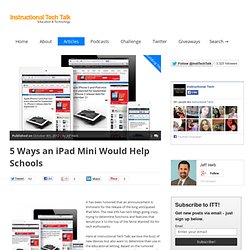

5 Ways an iPad Mini Would Help Schools. It has been rumored that an announcement is imminent for the release of the long anticipated iPad Mini.

The new info has tech blogs going crazy trying to determine functions and features that would put it to the top of the ‘Most Wanted’ list for tech enthusiasts. Here at Instructional Tech Talk, we love the buzz of new devices but also want to determine their use in the educational setting. Based on the rumored specs of the iPad Mini (see below if you are out of the loop), here are 6 ways that the unannounced iPad Mini would help schools.
Rumored Tech Specs:Screen Size: Smaller 7.85 in Retina DisplayAt least one cameraLightening ConnectorApple A5X processorLower PriceAt least Wi-Fi and Bluetooth – perhaps LTE. Classroom Technology - Integration vs. Innovation. Here’s the deal – and it is pretty straight forward… Those who integrate technology into the classroom are classroom technology integrators.

Those who innovate the classroom using technology are classroom technology innovators. Catch the difference? It’s more than just the difference between the definition of integration and innovation. Integrator Technology integration is easy. A Fun Way to Learn Anything with Memrise. I am constantly on the lookout for websites that provide the opportunity for learning to be fun and creative.

This is definitely the case with Memrise – a website that offers various free courses (such as learning a language and allows you to create your own course/flashcards to help study as well. The team at Memrise focuses on three components to help commit the content to memory: Science “The first is Science. We’re obsessed with using brain science to help you learn faster.
We use ‘mems’ to help you form vivid, sensory memories. Fun. Transfer notes and files using ‘Self Destructible Text Notes’ I found this very simple site that allows you to share text notes or share attachments that automatically destroy themselves (delete) after viewing or downloading.

There is one distinct use I can think of for the classroom: students submitting work without the need to have an email address. As soon as the teacher downloads the document, the server deletes the online note. It seems like a pretty cool tool that educators will likely find some pretty great uses for – let me know what you come up with. Here is a quick screen shot of what it looks like: We Must Be Patient When We Play. Facebook vs Education – Who Wins? I like to think that a large part of my day isn’t dedicated to roving the network looking for students that aren’t doing what they are supposed to be doing.

The reality is that no matter what I am doing at my desk, the monitoring software is always running on one of my screens. More often than not I can look up and see someone on Facebook. Let’s jump back a little and discuss why the social networking site isn’t blocked in our district. At one time, a couple years ago, it was blocked. Innovative Teaching and Learning with Khan Academy. I walked into work this morning and was immediately greeted by a co-worker saying, “We have to talk about 60 Minutes and Khan Academy.”

Clearly I was one of the few individuals who didn’t see the episode as it was a topic of discussion around the building all day. I found some time to sit down and look through the website and information and I now see why it is such a talking point. Another co-worker put it very eloquently. “So many things are created for the sake of simply using the technology. This is different, this has definite substance.” Facebook vs Education – Who Wins? Internet Filtering at Public Schools. “They let you access that site in your district?”

When I attend conferences, this is a very commonly repeated phrase. How can there be so many different policies regarding internet filtering? Using Twitter in the Classroom. There is no doubt that Twitter has taken social networking by storm – providing users the opportunity to say what they need to in a quick burst of 160 characters or less.

This has many practical applications, but what about education? Speaking from first hand experience, Twitter is an effective medium in the classroom. Here is how I utilized the service. 1. Create a ‘Classroom’ or ‘Teacher’ twitter handle. ITT 1 – TubeChop. ITT 2 – Recover Content from a Corrupt Word Doc. How To Published on April 9th, 2012 | by Jeff Herb.

ITT 3 – instaGrok. Once you get past the somewhat bizarre name, instaGrok will become your best friend.

Designed to be the educational version of Google (so it seems), instaGrok allows users to search based on what they need/want to learn. Search results are displayed in graphical form, allowing you to see what other keywords are associated with your original search term. Here are a few awesome features of the site: finds age-appropriate content on any topic with interactive multimedia (if available)generates quiz questions based on student?
S research activity and skill levelsupports creation of research journals and concept maps for learning assessment I have been very impressed with instaGrok and it is likely that they will get snapped up by another search giant before too long. Let us know how you use instaGrok in your classroom! Students Like Social Media. ITT 4 – Extend your Desktop when Projecting. How To Published on April 10th, 2012 | by Jeff Herb Projectors and SMART Boards are great – they let you display all sorts of info via your computer with minimal difficulty. The only limitation is that what is displayed on your screen is displayed to the whole class – and sometimes that can be an annoying limitation. Sometimes we need to enter attendance, grades, read an email, etc. – all of which shouldn’t be done publicly.
ITT 5 – Use Rizzoma for Collaboration. ITT 6 – Embed YouTube Videos in a PowerPoint. (These are the exact instructions for Office 2007) It is very common for people to use a YouTube video as a reference during a presentation. Usually, that requires stopping the show, opening your browser, finding the right video, and then clicking play. The alternative is to embed the video directly in your slide. You can set the PowerPoint to automatically play the video when the slide becomes active, set the video to loop when it is over, and change the size of the video to fit your needs. Quizlet – Quick eFlashcards. Tl;dr: Quizlet is a flashcard-based education website that allows users to create, share, and study flashcards in various ways. And it’s free. For years I have used Quizlet and have been able to watch it grow from a fledgling website into a powerhouse of an educational tool that millions of people use constantly.
With literally hundreds of millions flashcards created by users on the site, there is something for everyone likely already created. Edmodo – Facebook for the Classroom. There comes a time when you just can’t stop the students desire to use Facebook. And why should you? It imbibes all the great things about a classroom (except for the ability to monitor students and ensure they are being scholarly instead of dastardly).
Enter Edmodo.com – a Facebook-esque way to conduct your classroom. Contact Students and Parents via Text or Email using Remind101. Let’s face it – your students and a lot of parents emphatically check their phones and email.